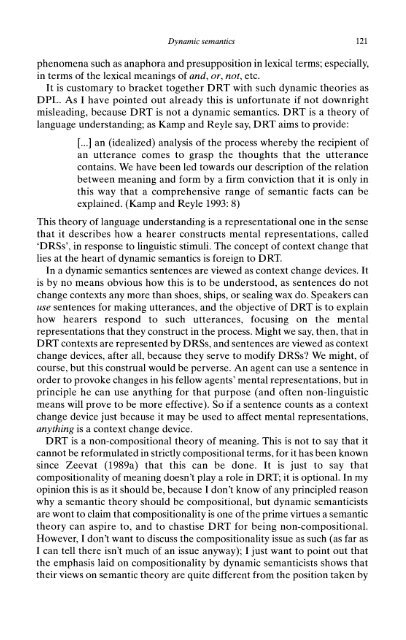Presuppositions and Pronouns - Nijmegen Centre for Semantics
Presuppositions and Pronouns - Nijmegen Centre for Semantics
Presuppositions and Pronouns - Nijmegen Centre for Semantics
You also want an ePaper? Increase the reach of your titles
YUMPU automatically turns print PDFs into web optimized ePapers that Google loves.
Dynamic semantics 121<br />
phenomena such as anaphora <strong>and</strong> presupposition in lexical terms; especially,<br />
in terms of the lexical meanings of <strong>and</strong>, or, not, etc.<br />
It is customary to bracket together DRT with such dynamic theories as<br />
DPL. As I have pointed out already this is un<strong>for</strong>tunate if not downright<br />
misleading, because DRT is not a dynamic semantics. DRT is a theory of<br />
language underst<strong>and</strong>ing; as Kamp <strong>and</strong> Reyle say, DRT aims to provide:<br />
[...] ] an (idealized) analysis of the process whereby the recipient of<br />
an utterance comes to grasp the thoughts that the utterance<br />
contains. We have been led towards our description of the relation<br />
between meaning <strong>and</strong> <strong>for</strong>m by a firm conviction that it is only in<br />
this way that a comprehensive range of semantic facts can be<br />
explained. (Kamp <strong>and</strong> Reyle 1993: 8)<br />
This theory of language underst<strong>and</strong>ing is a representational one in the sense<br />
that it describes how a hearer constructs mental representations, called<br />
'DRSs', in response to linguistic stimuli. The concept of context change that<br />
lies at the heart of dynamic semantics is <strong>for</strong>eign to DRT.<br />
In a dynamic semantics sentences are viewed as context change devices. It<br />
is by no means obvious how this is to be understood, as sentences do not<br />
change contexts any more than shoes, ships, or sealing wax do. Speakers can<br />
use sentences <strong>for</strong> making utterances, <strong>and</strong> the objective of DRT is to explain<br />
how hearers respond to such utterances, focusing on the mental<br />
representations that they construct in the process. Might we say, then, that in<br />
DRT contexts are represented by DRSs, <strong>and</strong> sentences are viewed as context<br />
change devices, after all, because they serve to modify DRSs We might, of<br />
course, but this construal would be perverse. An agent can use a sentence in<br />
order to provoke changes in his fellow agents' mental representations, but in<br />
principle he can use anything <strong>for</strong> that purpose (<strong>and</strong> often non-linguistic<br />
means will prove to be more effective). So if a sentence counts as a context<br />
change device just because it may be used to affect mental representations,<br />
anything is a context change device.<br />
DRT is a non-compositional theory of meaning. This is not to say that it<br />
cannot be re<strong>for</strong>mulated in strictly compositional terms, <strong>for</strong> it has been known<br />
since Zeevat (1989a) that this can be done. It is just to say that<br />
compositionality of meaning doesn't playa a role in DRT; it is optional. In my<br />
opinion this is as it should be, because I don't know of any principled reason<br />
why a semantic theory should be compositional, but dynamic semanticists<br />
are wont to claim that compositionality is one of the prime virtues a semantic<br />
theory can aspire to, <strong>and</strong> to chastise DRT <strong>for</strong> being non-compositional.<br />
However, I don't want to discuss the compositionality issue as such (as far as<br />
I can tell there isn't much of an issue anyway); I just want to point out that<br />
the emphasis laid on compositionality by dynamic semanticists shows that<br />
their views on semantic theory are quite different from the position taken by














